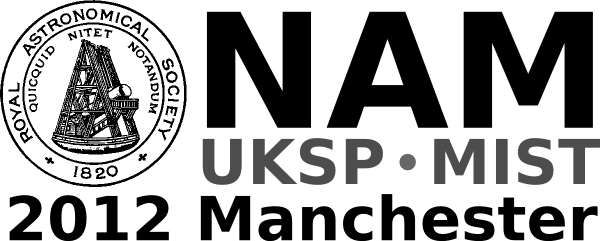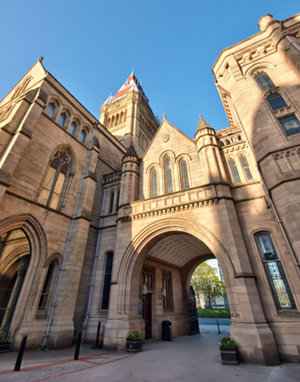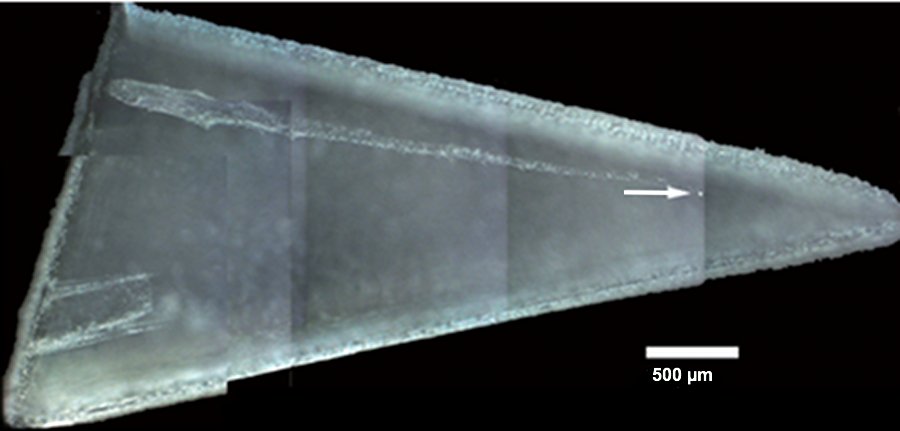UK-Germany National Astronomy Meeting NAM2012
Comet Wild2: First Evidence of Space Weathering
Royal Astronomical Society press release
RAS PR 12/28 (NAM 19)
Tuesday 27 March 2012
The traditional picture of comets as cold, icy, unchanging bodies throughout their history is being reappraised in the light of analyses of dust grains from Comet Wild2. A team led by the University of Leicester has detected the presence of iron in a dust grain, evidence of space weathering that could explain the rusty reddish colour of Wild2's outer surface. The results were presented by Dr John Bridges at the National Astronomy Meeting in Manchester on Tuesday 27th March.
The Wild2 grains were collected by the NASA Stardust mission and returned to Earth in 2006. The fast-moving dust grains were collected in arrays of aerogel, a silicon-based foam that is 99 per cent empty space, which slowed the particles from velocities of 6 kilometres a second to a halt over just a few millimetres. Since then, an international team of scientists has been analysing the samples and the carrot-shaped tracks that they left in the aerogel. Microscopic samples dissected from the grains have been analysed at facilities around the UK, and in particular this work was performed at the Diamond Light Source synchrotron in Oxfordshire and Leicester University. Through a range of analytical techniques, scientists in the UK have been able to fully analyse the mineralogy and isotopes of the samples."The total mass of Comet Wild2 grains returned is less than a milligram, so these samples are incredibly precious and a considerable analytical challenge," said Bridges, of the University of Leicester.
The analysis from the Microfocus Spectroscopy beamline at the Diamond synchrotron shows that the surface of Comet Wild2 has been bombarded by particles in the solar wind and micrometeorites throughout its 4.5 billion year history. This space weathering has deposited nanometre-size grains of iron metal and reddened the surface of the comet.
"This is the first mineralogical evidence for space weathering that has been identified in the Wild2 samples that was hinted at by other spectroscopic observations of the comet," said Bridges. "It adds another piece of the puzzle to our understanding of the life history of comets."
IMAGE AND CAPTION
Images of the Stardust mission and aerogel can be found at: http://stardust.jpl.nasa.gov/photo/index.html
Aerogel sample with track #170. Credit: Bridges/University of Leicester http://www.ras.org.uk/images/stories/NAM/2012/stardust_track.jpg
MEDIA CONTACTS
NAM 2012 Press Office (0900 - 1730 BST, 27-29 March; 0900 - 1630 BST 30 March)
Room 3.214
University Place building
University of Manchester
Manchester
UK
Tel: +44 (0)161 306 7313
Dr Robert Massey
Royal Astronomical Society
Mob: +44 (0)794 124 8035
Email: rm@ras.org.uk
Anita Heward
Royal Astronomical Society
Mob: +44 (0)7756 034 243
Email: anitaheward@btinternet.com
Dr Klaus Jaeger
Pressereferent / Press Officer im Vorstand der Astronomischen Gesellschaft
Tel: +49 6221 528 379
Email: pressereferent@astronomische-gesellschaft.de
Dan Cochlin
Media Officer (Faculty of Engineering and Physical Sciences)
University of Manchester
Tel: +44 (0)161 275 8387
Email: daniel.cochlin@manchester.ac.uk
SCIENCE CONTACTS
Dr John Bridges
University of Leicester
Tel: +44(0)116 252 2007
Email: j.bridges@le.ac.uk
NOTES FOR EDITORS
NAM 2012
Bringing together more than 900 astronomers and space scientists, the National Astronomy Meeting (NAM 2012) will take place from 27-30 March 2012 in the University Place conference centre at the University of Manchester in the UK. The conference is a joint meeting of the Royal Astronomical Society (RAS) and the German Astronomische Gesellschaft (AG) and is held in conjunction with the UK Solar Physics (UKSP: www.uksolphys.org) and Magnetosphere Ionosphere Solar Terrestrial (MIST: www.mist.ac.uk) meetings. NAM 2012 is principally sponsored by the RAS, AG, STFC and the University of Manchester.
The Royal Astronomical Society
The Royal Astronomical Society (RAS: www.ras.org.uk), founded in 1820, encourages and promotes the study of astronomy, solar-system science, geophysics and closely related branches of science. The RAS organises scientific meetings, publishes international research and review journals, recognizes outstanding achievements by the award of medals and prizes, maintains an extensive library, supports education through grants and outreach activities and represents UK astronomy nationally and internationally. Its more than 3500 members (Fellows), a third based overseas, include scientific researchers in universities, observatories and laboratories as well as historians of astronomy and others.
The Astronomische Gesellschaft (AG)
The Astronomische Gesellschaft (AG: www.astronomische-gesellschaft.de), founded in 1863, is a modern astronomical society with more than 800 members dedicated to the advancement of astronomy and astrophysics and the networking between astronomers. It represents German astronomers, organises scientific meetings, publishes journals, offers grants, recognises outstanding work through awards and places a high priority on the support of talented young scientists, public outreach and astronomy education in schools.
The Science and Technology Facilities Council
The Science and Technology Facilities Council (STFC: www.stfc.ac.uk) is keeping the UK at the forefront of international science and tackling some of the most significant challenges facing society such as meeting our future energy needs, monitoring and understanding climate change, and global security. The Council has a broad science portfolio and works with the academic and industrial communities to share its expertise in materials science, space and ground-based astronomy technologies, laser science, microelectronics, wafer scale manufacturing, particle and nuclear physics, alternative energy production, radio communications and radar. It enables UK researchers to access leading international science facilities for example in the area of astronomy, the European Southern Observatory.
Diamond Light Source
Diamond Light Source is funded by the UK Government via the Science and Technology Facilities Council (STFC) and by the Wellcome Trust. For more information about Diamond visit www.diamond.ac.uk
Diamond generates extremely intense pin-point beams of synchrotron light of exceptional quality ranging from X-rays, ultra-violet and infrared. For example Diamond's X-rays are around 100 billion times brighter than a standard hospital X-ray machine.
Many of our everyday commodities that we take for granted, from food manufacturing to cosmetics, from revolutionary drugs to surgical tools, from computers to mobile phones, have all been developed or improved using synchrotron light.
Jodrell Bank Centre for Astrophysics
The Jodrell Bank Centre for Astrophysics (JBCA: www.jb.man.ac.uk) is part of the School of Physics & Astronomy at the University of Manchester. JBCA is split over two main sites: the Alan Turing Building in Manchester and the Jodrell Bank Observatory in Cheshire. At Jodrell Bank Observatory, the new Jodrell Bank Discovery Centre is a key focus for our work in public engagement and education. Jodrell Bank is a world leader in radio astronomy-related research and technology development with a research programme extending across much of modern astrophysics. The group operates the e-MERLIN national radio astronomy facility and the iconic Lovell Telescope, hosts the UK ALMA Regional Centre Node and is home to the international office of the SKA Organisation. Funded by the University, the Science & Technology Facilities Council and the European Commission, it is one of the UK's largest astrophysics research groups.






